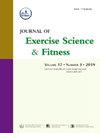自动调节阻力训练增强最大力量:系统回顾和网络荟萃分析
IF 2.4
2区 医学
Q2 SPORT SCIENCES
引用次数: 0
摘要
目的本研究旨在通过网络荟萃分析,系统回顾自动调节渐进式阻力训练(APRE)、感知用力等级(RPE)和基于速度的阻力训练(VBRT)对最大力量的影响。方法采用森林图和网络图可视化训练方式差异和干预关系。不同研究的混合标准平均差(SMD)和相应的95%置信区间(ci)量化了效应大小,不一致模型评估异质性,并在累积排序曲线(SUCRA)值下表面以最优概率排序方案。结果对于后蹲1RM,干预之间没有观察到中等/较大的效应量。SUCRA排名显示,APRE(93.0%)是最优干预措施,其次是RPE(66.8%)、VBRT(27.0%)和PBRT(13.2%)。在卧推1RM中,PBRT与APRE相比效果显著(SMD = - 0.83, - 1.22至- 0.44),而RPE与APRE相比效果适中(SMD = - 0.76, - 1.70至0.19)。SUCRA排名优先的是APRE(97.1%),其次是VBRT(57.1%)、RPE(29.9%)和PBRT(15.9%)。结论在本研究中,网络meta分析证实APRE、VBRT和RPE在增强最大强度方面明显优于PBRT。其中,APRE效果最大,对后蹲和卧推1RM的提高均排名第一,其次是VBRT、RPE和PBRT。本文章由计算机程序翻译,如有差异,请以英文原文为准。
Autoregulated resistance training for maximal strength enhancement: A systematic review and network meta-analysis
Objectives
This study aims to systematically review the effects of Autoregulating Progressive Resistance Exercise (APRE), Rating of Perceived Exertion (RPE), and Velocity-based Resistance Training (VBRT) on maximal strength through a network meta-analysis.
Methods
Forest plots and network diagrams visualized training modality differences and intervention relationships. Pooled standard mean difference (SMD) of different studies and the corresponding 95 % confidence intervals (CIs) quantified effect sizes, with inconsistency models assessing heterogeneity and surface under the cumulative ranking curve (SUCRA) values ranking protocols by optimal probability.
Results
For back squat 1RM, no moderate/large effect sizes were observed between interventions. SUCRA rankings showed APRE (93.0 %) as the most optimal intervention, followed by RPE (66.8 %), VBRT (27.0 %), and PBRT (13.2 %). In bench press 1RM, PBRT demonstrated a large effect vs APRE (SMD = −0.83, −1.22 to −0.44), while RPE showed a moderate effect vs APRE (SMD = −0.76, −1.70 to 0.19). SUCRA rankings prioritized APRE (97.1 %), followed by VBRT (57.1 %), RPE (29.9 %), and PBRT (15.9 %).
Conclusion
In this study, the network meta-analysis confirmed that APRE, VBRT, and RPE were significantly more effective than PBRT in enhancing maximum strength. Among these, APRE demonstrated the greatest effect, ranking first in the improvement of both the back squat and bench press 1RM, followed by VBRT, RPE, and PBRT.
求助全文
通过发布文献求助,成功后即可免费获取论文全文。
去求助
来源期刊
CiteScore
5.10
自引率
3.60%
发文量
54
审稿时长
31 days
期刊介绍:
The Journal of Exercise Science and Fitness is the official peer-reviewed journal of The Society of Chinese Scholars on Exercise Physiology and Fitness (SCSEPF), the Physical Fitness Association of Hong Kong, China (HKPFA), and the Hong Kong Association of Sports Medicine and Sports Science (HKASMSS). It is published twice a year, in June and December, by Elsevier.
The Journal accepts original investigations, comprehensive reviews, case studies and short communications on current topics in exercise science, physical fitness and physical education.

 求助内容:
求助内容: 应助结果提醒方式:
应助结果提醒方式:


